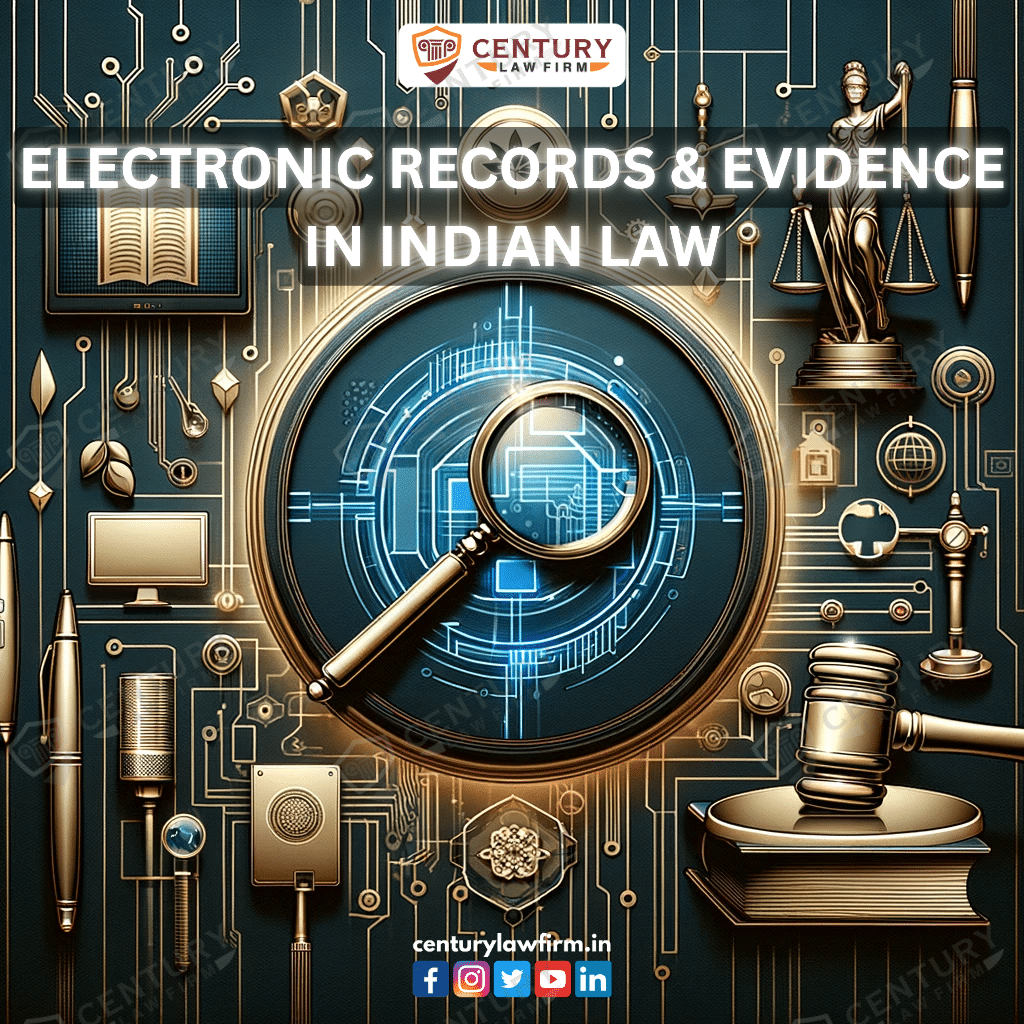Introduction
Evolution of Digital Evidence and Its Growing Importance
The landscape of evidence in legal proceedings has undergone a significant transformation with the advent of the digital age. In India, as in many parts of the world, the role of digital evidence has been steadily increasing, reflecting the profound impact of technology on society. This evolution is characterized by a shift from reliance on physical documents and oral testimony to a more nuanced and complex reliance on electronic records.
Digital evidence includes a wide array of electronic materials, such as emails, text messages, social media posts, digital photographs, and even information extracted from IoT (Internet of Things) devices. The versatility and ubiquity of digital information pose both opportunities and challenges in the legal context. On the one hand, digital evidence can be more easily stored, searched, and transmitted. On the other hand, issues related to authenticity, privacy, and technical complexity arise.
In India, the legal framework governing electronic records and digital evidence has been evolving to keep pace with technological advancements. This is evident in amendments to various laws, including the Indian Evidence Act and the Information Technology Act, which recognize and regulate digital evidence. These legislative changes underscore the growing importance of understanding the nuances of electronic records in legal proceedings.
Transition from Traditional Forms of Evidence
The transition from traditional forms of evidence to digital evidence marks a significant shift in legal practice. Traditional evidence, comprising mainly of physical documents, tangible items, and oral testimonies, has a long history in the judicial process. The introduction of electronic evidence brings a paradigm shift, requiring legal professionals to acquire new skills and adapt to new methodologies.
This transition is not just technical but also cultural. It challenges long-standing legal principles, such as the best evidence rule, which traditionally preferred original over secondary copies. With digital evidence, the distinction between original and copy is often blurred, requiring courts and legal practitioners to rethink conventional concepts.
International Trends and Global Best Practices
Internationally, the approach to electronic records and digital evidence is continually evolving. Countries like the United States, the United Kingdom, and members of the European Union have developed comprehensive frameworks and guidelines to manage digital evidence effectively. These frameworks often emphasize principles such as authenticity, integrity, reliability, and accessibility of digital evidence.
Global best practices in handling digital evidence include strict adherence to chain-of-custody procedures, use of standardized formats for electronic discovery (eDiscovery), and employment of forensically sound methods for data extraction and preservation. These practices ensure that digital evidence remains reliable and admissible in court.
India, in its quest to align with these international trends, has been updating its legal provisions and training its judiciary and law enforcement agencies. These efforts are aimed at enhancing the competency in dealing with the intricacies of digital evidence, thereby strengthening the legal system’s ability to administer justice in the digital age.
In summary, the evolution of digital evidence in Indian law is a reflection of the broader global trends in legal practice, necessitating a comprehensive understanding of the nuances of electronic records. This guide aims to navigate through these complexities, providing insights into the current state of digital evidence in India and the best practices adopted globally.

Relevant Legal Framework in India
The legal framework governing electronic records in India is primarily derived from two key legislations: The Indian Evidence Act, 1872, and the Information Technology (IT) Act, 2000. These acts provide the foundational legal basis for the admissibility, relevance, and authentication of electronic records in Indian courts.
Indian Evidence Act, 1872 – Key Sections
The Indian Evidence Act, established in 1872, has been amended to incorporate provisions for electronic records. Key sections relevant to electronic records include:
- Section 65B: Pertains to the admissibility of electronic records. It states that any information contained in an electronic record, which is printed on a paper, stored, recorded, or copied in optical or magnetic media, is deemed to be a document and is admissible in legal proceedings, without the need for the original device.
- Section 85A: Deals with the presumption as to electronic agreements, recognizing them as valid and binding.
- Section 85B: Relates to the presumption as to electronic records and digital signatures, giving them the same recognition as physical signatures.
- Section 88A: Recognizes electronic messages as evidence, assuming the identity of the sender and the integrity of the communication, unless proven otherwise.
IT Act, 2000
The Information Technology Act, 2000, was primarily enacted to provide legal recognition for transactions carried out by means of electronic data interchange and other means of electronic communication. Key points include:
- Section 43A: Imposes compensation for failure to protect data.
- Section 66: Criminalizes the act of hacking and data theft.
- Section 72A: Provides for penalties for breach of confidentiality and privacy in the context of electronic records.
Comparative Analysis with Global Regulations
Globally, the approach to electronic records varies, but there are common threads. For instance, the EU’s General Data Protection Regulation (GDPR) emphasizes data protection and privacy, while the United States’ Electronic Communications Privacy Act (ECPA) and the Federal Rules of Civil Procedure (FRCP) focus on the admissibility and management of electronic evidence. The key difference lies in the specific provisions and the extent of emphasis on privacy and security.
Evidentiary Standards in Electronic Records
In India, as well as globally, electronic records must meet certain evidentiary standards to be admissible in court. These include authenticity (the record truly comes from its purported source), reliability (the record has been maintained in a manner that assures its integrity), and relevance (the record is relevant to the case at hand). Additionally, compliance with prescribed procedures for the storage and retrieval of such records is crucial.
Section 2: Section 65B of Indian Evidence Act
Full Text & Clause-by-Clause Explanation
Section 65B of Indian Evidence Act:
65B. Admissibility of electronic records. –– (1) Notwithstanding anything contained in this Act, any information contained in an electronic record which is printed on a paper, stored, recorded or copied in optical or magnetic media produced by a computer (hereinafter referred to as the computer output) shall be deemed to be also a document, if the conditions mentioned in this section are satisfied in relation to the information and computer in question and shall be admissible in any proceedings, without further proof or production of the original, as evidence or any contents of the original or of any fact stated therein of which direct evidence would be admissible.
(2) The conditions referred to in sub-section (1) in respect of a computer output shall be the following, namely: ––
(a) the computer output containing the information was produced by the computer during the period over which the computer was used regularly to store or process information for the purposes of any activities regularly carried on over that period by the person having lawful control over the use of the computer;
(b) during the said period, information of the kind contained in the electronic record or of the kind from which the information so contained is derived was regularly fed into the computer in the ordinary course of the said activities;
(c) throughout the material part of the said period, the computer was operating properly or, if not, then in respect of any period in which it was not operating properly or was out of operation during that part of the period, was not such as to affect the electronic record or the accuracy of its contents; and
(d) the information contained in the electronic record reproduces or is derived from such information fed into the computer in the ordinary course of the said activities.
(3) Where over any period, the function of storing or processing information for the purposes of any activities regularly carried on over that period as mentioned in clause (a) of sub-section (2) was regularly performed by computers, whether––
(a) by a combination of computers operating over that period; or
(b) by different computers operating in succession over that period; or
(c) by different combinations of computers operating in succession over that period; or
(d) in any other manner involving the successive operation over that period, in whatever order, of one or more computers and one or more combinations of computers, all the computers used for that purpose during that period shall be treated for the purposes of this section as constituting a single computer; and references in this section to a computer shall be construed accordingly.
(4) In any proceedings where it is desired to give a statement in evidence by virtue of this section, a certificate doing any of the following things, that is to say, ––
(a) identifying the electronic record containing the statement and describing the manner in which it was produced;
(b) giving such particulars of any device involved in the production of that electronic record as may be appropriate for the purpose of showing that the electronic record was produced by a computer;
(c) dealing with any of the matters to which the conditions mentioned in sub-section (2) relate, and purporting to be signed by a person occupying a responsible official position in relation to the operation of the relevant device or the management of the relevant activities (whichever is appropriate) shall be evidence of any matter stated in the certificate; and for the purposes of this subsection it shall be sufficient for a matter to be stated to the best of the knowledge and belief of the
person stating it.
(5) For the purposes of this section, ––
(a) information shall be taken to be supplied to a computer if it is supplied thereto in any appropriate form and whether it is so supplied directly or (with or without human intervention) by means of any appropriate equipment;
(b) whether in the course of activities carried on by any official, information is supplied with a view to its being stored or processed for the purposes of those activities by a computer operated otherwise than in the course of those activities, that information, if duly supplied to that computer, shall be taken to be supplied to it in the course of those activities;
(c) a computer output shall be taken to have been produced by a computer whether it was produced by it directly or (with or without human intervention) by means of any appropriate equipment.
Explanation.––For the purposes of this section any reference to information being derived from other information shall be a reference to its being derived therefrom by calculation, comparison or any other process.]
Section 65B of the Indian Evidence Act is a cornerstone in the legal framework regarding electronic records in India. It details how electronic records should be treated within the judicial system. Let’s break down its clauses for a clearer understanding:
- Section 65B (1): It marks the acceptance of electronic records as evidence. This clause is revolutionary as it allows for electronic data – encompassing a vast spectrum from emails to digital recordings – to be considered equivalent to physical documents in legal settings.
- Section 65B (2): This part outlines the conditions that need to be met for the electronic record to be deemed admissible. It includes stipulations about the regular usage of the computer for lawful activities and the functioning of the computer during the period of relevance. This is crucial for establishing the reliability of the data.
- Section 65B (3): This part addresses the scenario where multiple computers, or different combinations of computers, have been used over a period for the purpose of storing or processing information for regularly carried out activities. This section clarifies that all such computers, whether operating individually, in succession, or in any combination over that period, are to be treated as a single computer for the purposes of the Act. This provision ensures a holistic approach in considering electronic evidence, recognizing the complexity and variability in modern computing environments.
- Section 65B (4): Perhaps the most critical clause, it mandates a certificate to accompany the electronic record. This certificate, issued by a responsible authority/person, validates the electronic record and is necessary for its admissibility in court.
- Sub-section (5) clarifies the scope and definition of information supply to a computer. It encompasses the following:
- Information supplied in any form directly or indirectly to a computer is recognized.
- Information supplied for storage or processing in any official activity, even if the computer is operated outside those activities, is considered part of those activities.
- A computer output is recognized as produced by a computer, whether directly or indirectly.
Judicial Interpretations
The interpretation of Section 65B has been subject to significant judicial scrutiny, evolving with landmark judgments that shape its application.
State vs Navjot Sandhu (2005)
In the landmark case of State vs Navjot Sandhu, concerning the 2001 Indian Parliament attack, the Supreme Court ruled that electronic records, particularly mobile phone records, could be admitted as evidence even without a certificate under Section 65B. This judgment was pivotal in recognizing electronic evidence’s importance and utility in legal proceedings.
Anvar P.V. vs P.K Basheer (2014)
Contrasting the earlier stance in Navjot Sandhu, the Supreme Court in Anvar P.V. vs P.K Basheer emphasized the mandatory requirement of a certificate under Section 65B(4) for the admissibility of an electronic record as secondary evidence. This judgment underscored the importance of compliance with statutory requirements, reinforcing the procedural sanctity in handling electronic evidence.
This particular judgment marked a significant shift, bringing forth a stringent approach towards the admissibility of electronic records, aligning more closely with the intent of the legislators when Section 65B was formulated.
Shafhi Mohammad vs State of HP (2018)
The Supreme Court’s decision in Shafhi Mohammad vs State of Himachal Pradesh (2018) further nuanced the understanding of Section 65B. In this case, the Court relaxed the requirement of a certificate under Section 65B(4) for certain scenarios. Specifically, it was held that if an electronic record is produced by a person who is not in possession of the device from which the electronic record is produced, the requirement of a certificate is not always mandatory. This judgment aimed to address practical difficulties and ensure that justice is not denied due to procedural technicalities.
Arjun Panditrao Khotkar vs Kailash Gorantyal (2020)
In Arjun Panditrao Khotkar vs Kailash Gorantyal (2020), the Supreme Court overruled the decision in Shafhi Mohammad to an extent. It was clarified that the certificate requirement under Section 65B(4) is a necessity for the admissibility of any electronic record. The court acknowledged the challenges in obtaining such certificates but emphasized the importance of this procedural safeguard to ensure the reliability of electronic evidence. This judgment represents the current position of law regarding the admissibility of electronic records in India.
Decoding Each Sub-section
Each sub-section of Section 65B serves a distinct purpose in ensuring the admissibility and reliability of electronic evidence:
- Sub-section (1) establishes the foundation for electronic records to be considered as evidence.
- Sub-section (2) provides the criteria for an electronic record to be reliable, focusing on the regular use of the computer and the integrity of data processing.
- Sub-section (3) emphasizes that the continuity and integrity of the electronic record are maintained, regardless of the number of devices involved.
- Sub-section (4), with its certificate requirement, acts as a crucial authentication tool, certifying the legitimacy of the electronic record and the process of its creation.
- Sub-section (5) ensures a broad understanding of how information is treated when supplied to a computer, relevant for legal proceedings involving electronic records.
Flowchart on Sec 65B Requirements
To enhance understanding, a flowchart delineating the requirements of Section 65B can be immensely helpful. This visual tool will illustrate the steps and conditions necessary for the admissibility of electronic evidence as per this section. Let’s create a detailed flowchart to encapsulate these requirements.
The flowchart above provides a visual breakdown of the requirements under Section 65B of the Indian Evidence Act for the admissibility of electronic records. It systematically outlines each sub-section, highlighting their specific roles and stipulations:
- Sub-section (1) establishes electronic records as potential evidence.
- Sub-section (2) sets the criteria for the reliability of these records.
- Sub-section (3) ensures the continuity and integrity of the electronic record are maintained, regardless of the number of devices involved.
- Sub-section (4) mandates the certificate requirement for authenticating the electronic record.
- Sub-section (5) gives definition and scope of information supply to computer
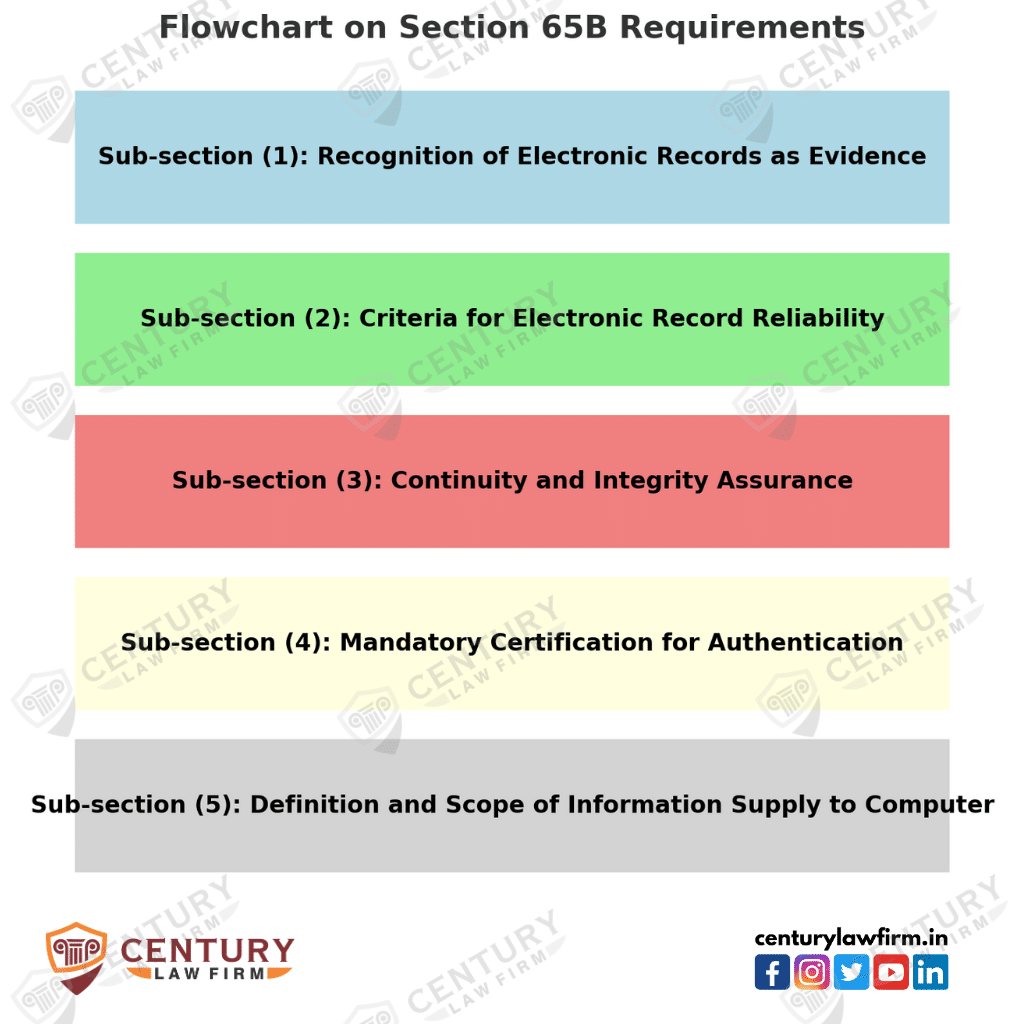
This flowchart serves as a valuable tool for understanding the procedural intricacies involved in presenting electronic records as evidence in legal proceedings.
Section 3: Admissibility of Electronic Evidence
Criteria for Admissibility in India
The admissibility of electronic evidence in Indian courts is governed by a set of criteria designed to ensure the integrity and reliability of such evidence. These criteria include relevance, authenticity, non-tampering, and reliability.
- Relevance: This is the foundational criterion for any evidence, electronic or otherwise. The evidence must be pertinent to the matter at hand in the litigation. Under the Indian Evidence Act, evidence is deemed relevant if it is directly or indirectly connected to the facts in dispute.
- Authenticity: For electronic evidence to be admissible, it must be proven authentic. This means that the evidence must be shown to be what it purports to be. For instance, a digital document or an email must be proven to originate from the alleged source.
- Non-Tampering: Given the malleable nature of digital data, it’s crucial to establish that the electronic evidence has not been tampered with or altered. The integrity of the data from the time of its creation to its presentation in court must be maintained.
- Reliability: This criterion relates to the quality and consistency of the electronic evidence. It must be collected, stored, and transferred in a manner that preserves its reliability. This includes ensuring that the systems and processes used to handle the electronic evidence are secure and robust.
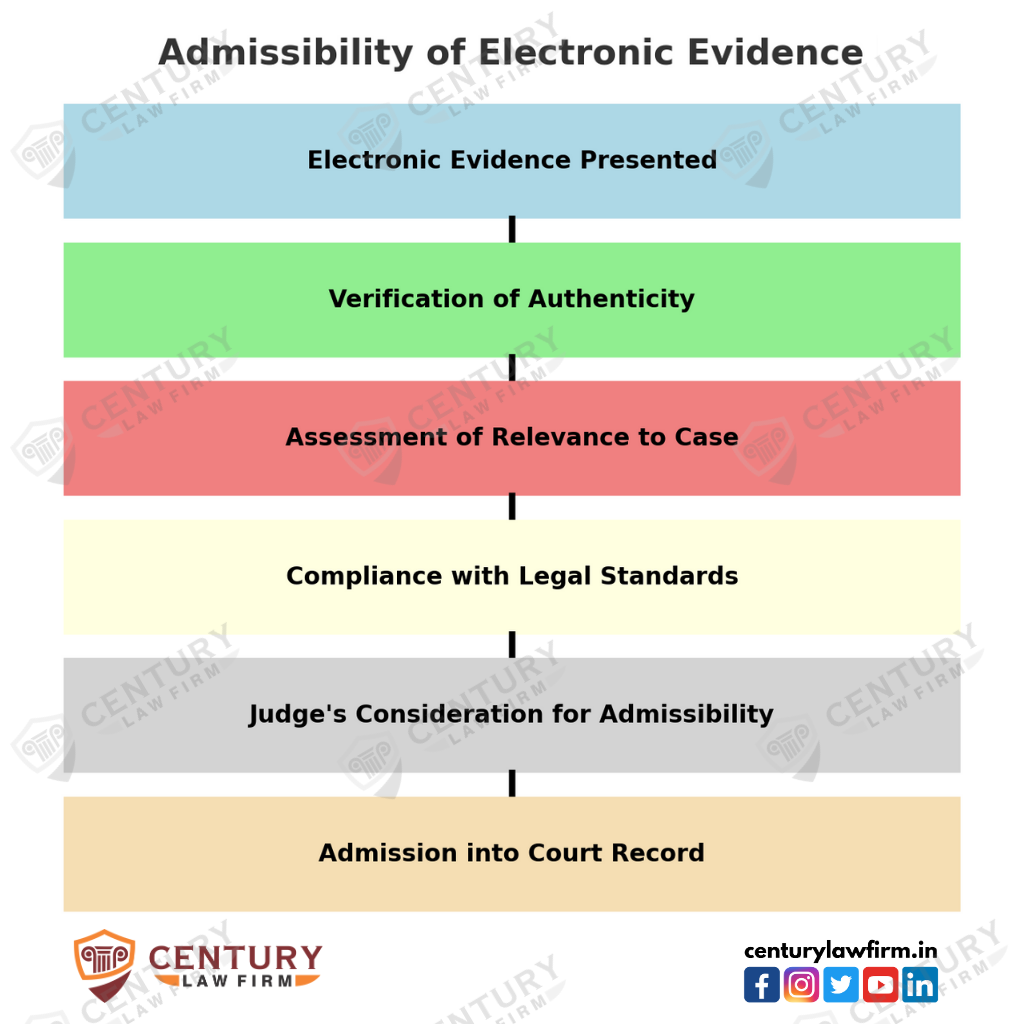
Hearsay Rules
In Indian law, hearsay evidence, or the information gathered by someone other than the witness testifying in court, is generally not admissible. However, electronic records often present unique challenges to this rule. For instance, an email or text message, while essentially being a second-hand account, can be admissible under certain conditions, especially if it meets the criteria of Section 65B of the Evidence Act.
Comparison with Global Jurisdictions
The criteria for the admissibility of electronic evidence in India have parallels in many global jurisdictions, albeit with some variations:
- United States: The Federal Rules of Evidence govern the admissibility of electronic evidence. The rules emphasize the authenticity and reliability of the evidence, similar to Indian standards. Additionally, the US has the concept of the ‘best evidence rule’, which necessitates the original document’s presentation unless valid reasons are provided for its absence.
- European Union: Under the GDPR and various national laws, there is a strong emphasis on the protection of personal data in electronic evidence. The authenticity and integrity of electronic records are also crucial, similar to Indian law.
- United Kingdom: The UK follows principles similar to those in India and the US, with a strong emphasis on the authenticity and reliability of electronic evidence. The UK’s Data Protection Act also influences the handling and admissibility of electronic data in legal proceedings.

Case Studies & Landmark Indian Judgments
The admissibility of electronic evidence in India has been significantly shaped by a series of landmark judgments. These cases have established key principles and have often redefined the legal landscape regarding the handling and admissibility of electronic records.
State vs Navjot Sandhu (2005)
In this case, also known as the Parliament Attack Case, the Supreme Court made a pioneering decision regarding electronic evidence. The Court allowed the admissibility of mobile phone records without a certificate under Section 65B of the Evidence Act. This judgment was crucial for its time, highlighting the importance and relevance of electronic evidence in criminal proceedings.
Anvar P.V. vs P.K Basheer (2014)
This judgment marked a significant shift from the precedent set in the Navjot Sandhu case. The Supreme Court clarified that an electronic record by way of secondary evidence shall not be admitted unless it is accompanied by a certificate as required under Section 65B(4). This judgment placed a mandatory requirement on the certification of electronic records, emphasizing the procedural authenticity of digital evidence.
Shafhi Mohammad vs State of HP (2018)
In Shafhi Mohammad vs State of Himachal Pradesh, the Supreme Court made a departure from the stringent requirement of a certificate under Section 65B(4) in certain situations. It stated that if the electronic record is produced by a person who is not in possession of the device, then the requirement for such a certificate is not mandatory. This ruling addressed practical difficulties and access to justice issues.
Arjun Panditrao Khotkar vs Kailash Gorantyal (2020)
Overruling the decision in Shafhi Mohammad to an extent, the Supreme Court in Arjun Panditrao Khotkar vs Kailash Gorantyal reiterated the necessity of the certificate requirement under Section 65B(4) for the admissibility of electronic records. This judgment re-emphasized the importance of procedural compliance in the presentation of digital evidence.
Key Principles Established
These judgments collectively have established several key principles in the realm of electronic evidence:
- Mandatory Certification: The necessity of a certificate under Section 65B(4) for the admissibility of electronic evidence.
- Relevance and Authenticity: Emphasis on the relevance and authenticity of electronic records as critical factors for admissibility.
- Practical Considerations: Recognition of practical challenges in obtaining certificates and handling electronic evidence.
Timeline of Landmark Judgments on Electronic Evidence
A timeline illustrating these landmark judgments can provide a clear chronological understanding of how the legal framework surrounding electronic evidence in India has evolved. Let’s create a timeline that captures these pivotal cases and their impact on the admissibility of electronic evidence in India.
2005: State vs Navjot Sandhu
- Significance: Recognized the admissibility of electronic records such as mobile phone records without a certificate under Section 65B of the Evidence Act.
- Impact: Set a precedent for the acceptance of electronic evidence in criminal cases, highlighting its growing importance in the judicial system.
2014: Anvar P.V. vs P.K Basheer
- Significance: Overturned the precedent set in Navjot Sandhu by mandating a certificate under Section 65B(4) for the admissibility of electronic records.
- Impact: Emphasized procedural compliance and the authenticity of electronic evidence, thereby strengthening the legal framework for digital records.
2018: Shafhi Mohammad vs State of HP
- Significance: Relaxed the certificate requirement under certain conditions, addressing practical challenges in procuring such certificates.
- Impact: Balanced the stringent requirements of the 2014 judgment with practical considerations, making the process more accessible.
2020: Arjun Panditrao Khotkar vs Kailash Gorantyal
- Significance: Reaffirmed the necessity of the certificate requirement under Section 65B(4), overruling the relaxation provided in the Shafhi Mohammad case.
- Impact: Reinforced the importance of procedural safeguards in the admission of electronic evidence, ensuring the reliability and integrity of digital records in legal proceedings.
This timeline illustrates the dynamic nature of the Indian legal system’s approach to electronic evidence. Each judgment reflects an evolving understanding of technology’s role in legal matters, balancing the need for procedural rigor with practical realities.
Section 4: Types of Electronic Evidence
Email and Electronic Communication
Email and other forms of electronic communication, such as instant messages and social media interactions, have become commonplace as sources of evidence in legal proceedings. They can provide vital information about the intentions, actions, and whereabouts of individuals and entities.
Authentication Requirements per Indian Laws
In the Indian legal system, the authentication of electronic communication is governed primarily by Section 65B of the Evidence Act. To authenticate such communication, the following are required:
- Certificate under Section 65B(4): This certificate is essential for authenticating electronic records, including emails and electronic communications. It must be signed by a person occupying a responsible official position in relation to the operation of the relevant device or the management of relevant activities.
- Chain of Custody: The process of collecting, storing, and presenting electronic communication must maintain an unbroken chain of custody to prevent tampering or alteration.
- Metadata Analysis: The examination of metadata, like sender and recipient information, timestamps, and routing data, is critical for establishing the authenticity of electronic communications.
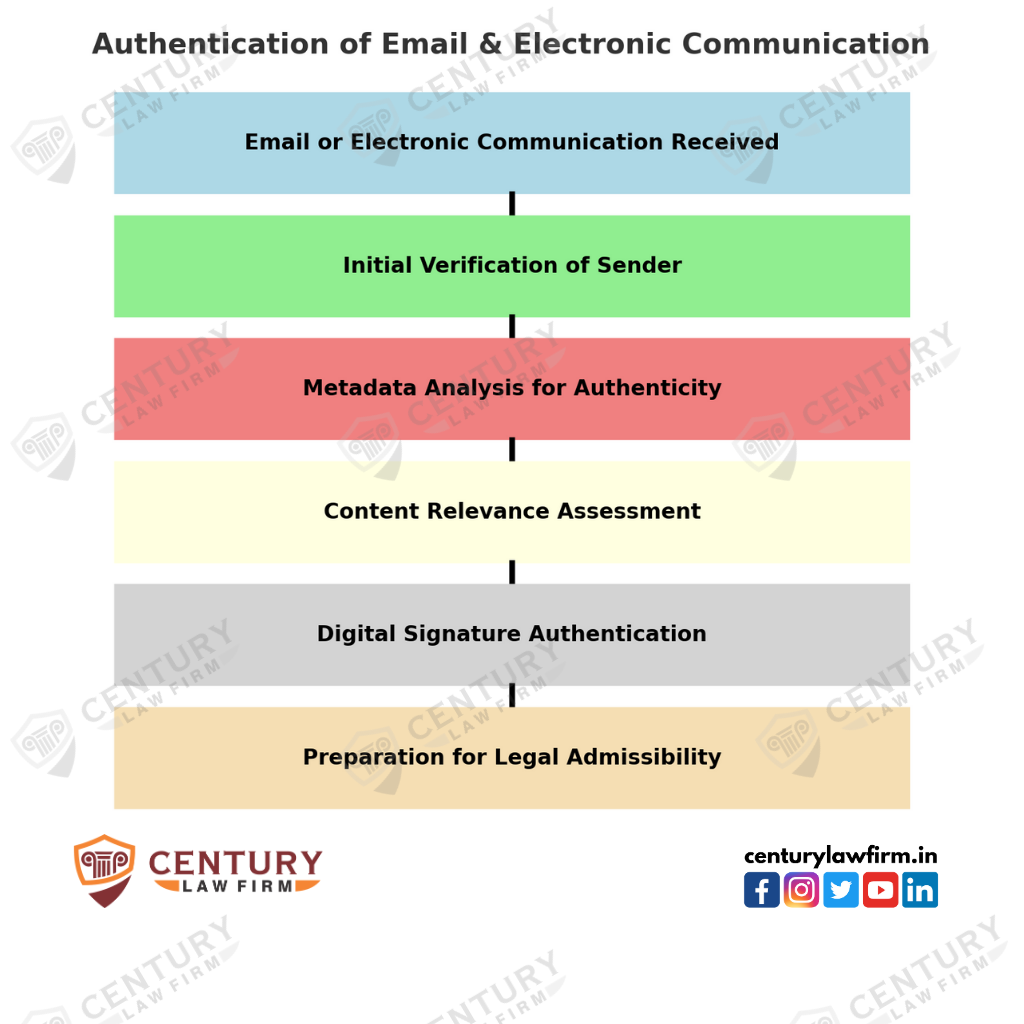
Primary vs Secondary Evidence Debate
The classification of electronic evidence as primary or secondary evidence is a subject of debate. In Indian law:
- Primary Evidence: It refers to the original document or record. For electronic records, this could mean the original digital file or data.
- Secondary Evidence: This includes any copy or reproduction of the original document or record. With electronic evidence, this often involves printouts or digital copies of the original electronic record.

The distinction is crucial because, traditionally, primary evidence is given more weight than secondary evidence. However, in the context of electronic records, this distinction can often be blurred, leading to legal challenges and debates.

Evidentiary Standards in India vs Other Countries
The evidentiary standards for electronic evidence in India align with international practices but have unique characteristics:
- India: Adheres to the stipulations of Section 65B of the Evidence Act, with a strong emphasis on certification and authenticity. The Indian legal framework has evolved through various landmark judgments to address the challenges posed by electronic evidence.
- United States: Governed by the Federal Rules of Evidence, which emphasize the authenticity and reliability of electronic evidence. The US also follows the ‘best evidence rule’ for original documents.
- European Union: Focuses heavily on data protection and privacy, especially under the GDPR. The authenticity and integrity of electronic records are essential, similar to Indian standards.
- United Kingdom: Similar to India and the US, the UK places a strong emphasis on the authenticity and reliability of electronic evidence. The UK’s Data Protection Act also plays a role in how electronic data is handled in legal contexts.
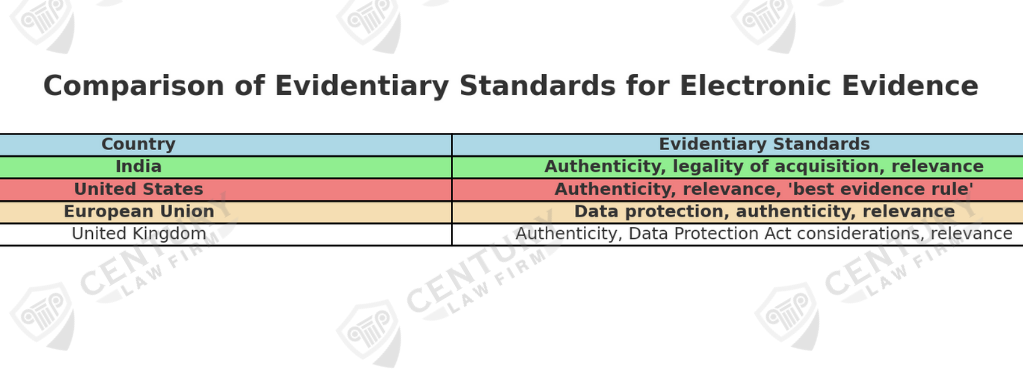
Judicial Approach on Email Evidence Admissibility
In Indian courts, emails are increasingly being recognized as a legitimate form of evidence. However, their admissibility hinges on meeting certain criteria:
- Authenticity: The origin and authenticity of the email must be verifiable. This often involves tracing the email back to its source and verifying the sender’s identity.
- Integrity: The content of the email must be proven to have remained unaltered.
- Relevance: The email must be relevant to the matter at hand in the litigation.
Indian courts have progressively adopted a practical approach towards email evidence, acknowledging its ubiquity in modern communication.
Social Media Evidence
Social media evidence includes content from platforms like Facebook, Twitter, Instagram, and LinkedIn. Its admissibility in Indian courts also depends on authenticity, relevance, and whether it has been tampered with. The courts are increasingly accepting social media evidence, given its growing importance in today’s digital world.
Privacy Issues in Indian Context
The use of electronic evidence, particularly from social media and emails, raises significant privacy concerns. In India, privacy is a fundamental right under Article 21 of the Constitution. Courts must balance the need for evidence with the privacy rights of individuals. This has led to a cautious approach, where the relevance and necessity of such evidence are carefully weighed against privacy concerns.
Right to Remove Controversy
The “right to be forgotten” or the right to remove personal information from internet platforms is an emerging debate in India. While not explicitly recognized in current Indian law, it is becoming increasingly relevant in the context of digital evidence and privacy.
Determining Evidentiary Value
The evidentiary value of electronic records, including social media posts and emails, is determined based on their relevance, authenticity, and the extent to which they can be corroborated with other evidence. Indian courts have been evolving their approach to assess and weigh this form of evidence appropriately.
Judicial Approach on Evaluating Social Media Evidence
Indian courts are navigating the challenges posed by social media evidence, such as issues of authenticity and potential for manipulation. The judiciary is developing a framework to evaluate such evidence critically, ensuring that it meets the standards of reliability and relevance.
Cell Phone & Call Recordings
Call recordings and data retrieved from cell phones are another significant form of electronic evidence. Their admissibility is contingent upon proper authentication, adherence to privacy laws, and confirmation that the recordings have not been tampered with. The legal framework around such evidence is continually evolving, reflecting technological advancements and privacy considerations.
Laws on Consent Requirements
In the Indian legal context, consent plays a critical role in the admissibility of electronic evidence, especially for private communications. The Information Technology Act, 2000, and the Indian Telegraph Act, 1885, provide the legal framework for this:
- Information Technology Act: Addresses the privacy and security aspects of electronic communications. Unauthorized access, capturing, sharing, or transmission of such communications without consent is considered a violation.
- Telegraph Act: Governs the interception of calls and messages. It permits the interception and monitoring under specific conditions, primarily for the reasons of national security or public safety, and requires authorization from a competent authority.
Obtaining Call Data Records through Legal Procedures
Call Data Records (CDRs) can be pivotal in legal investigations. To obtain these records:
- Legal Authorization: A court order or authorization from a designated government authority is typically required.
- Reasonable Grounds: The request for CDRs must be backed by reasonable grounds, suggesting its necessity for the investigation.
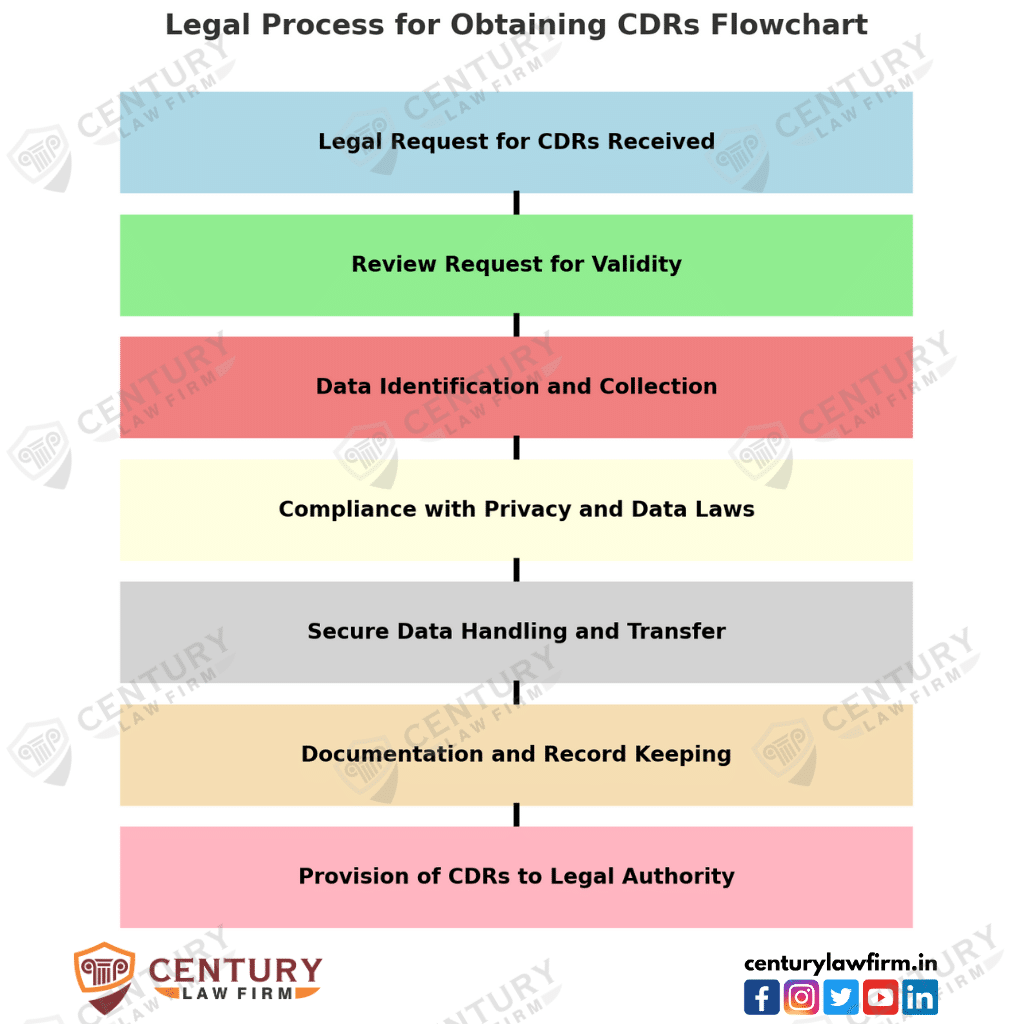
Judicial Scrutiny of Call Records & Tapped Conversations
Indian courts scrutinize CDRs and tapped conversations carefully:
- Admissibility: Courts consider the legality of how the records were obtained and whether due process was followed.
- Relevance: The relevance of the records to the case at hand is critically assessed.
- Privacy Concerns: Balancing the evidence’s utility against potential privacy infringements is a key consideration.
Photos & Videos
Photos and videos are increasingly used as evidence. Their admissibility depends on:
- Authenticity: Establishing that the photo or video is genuine and unaltered.
- Source Verification: Tracing the origin of the photo or video.
- Context and Relevance: Ensuring that the content is relevant to the case and presented in the correct context.
Manipulation Checks & Forensic Tools to Verify Origins
Forensic tools are used to check for manipulation:
- Metadata Analysis: Examining data like timestamps, camera details, and location information.
- Image/Video Analysis Tools: Detecting alterations or edits in the content.
Evidentiary Standards in India vs Global Benchmarks
Comparing India’s standards with global benchmarks:
- India: Focuses on the authenticity, legality of acquisition, and relevance of the evidence.
- Global: Similar emphasis on authenticity and relevance, with varying degrees of procedural requirements.
Judicial Approach to Photos & Videos as Evidence
Indian judiciary’s approach:
- Critical Analysis: Courts undertake a thorough examination of such evidence, considering the possibility of digital manipulation.
- Corroboration: Preference for corroborating the electronic evidence with other forms of evidence.
Section 5: Authenticating Electronic Evidence
Technical Aspects of Source Attribution
Source attribution in the context of electronic evidence involves tracing the origin of a digital document or communication. This process is critical in establishing the authenticity of electronic evidence. Key technical aspects include:
- IP Address Tracking: Identifying the source IP address of emails or online messages to trace their origin.
- Device Identification: Using unique identifiers of devices, such as MAC addresses, to establish the source of electronic evidence.
- Network Logs: Analyzing logs from networks and servers to trace the activity related to the electronic evidence.
Digital Signatures, Blockchains & Timestamping
These technologies play a vital role in the authentication process:
- Digital Signatures: Provide a secure and tamper-evident seal on digital documents, verifying the identity of the sender and ensuring the integrity of the content.
- Blockchain Technology: Offers a decentralized and immutable ledger system, useful for maintaining secure and verifiable records of transactions and documents.
- Timestamping: Ensures that the date and time of creation, modification, or transmission of digital evidence are accurately recorded, adding another layer of authenticity.
Metadata Forensic Analysis
Metadata analysis is crucial in examining electronic documents:
- Understanding Metadata: Metadata includes information like creation date, author details, and modification history of a digital document.
- Forensic Tools: Various software tools are used to extract and analyze metadata, providing insights into the history and authenticity of the document.
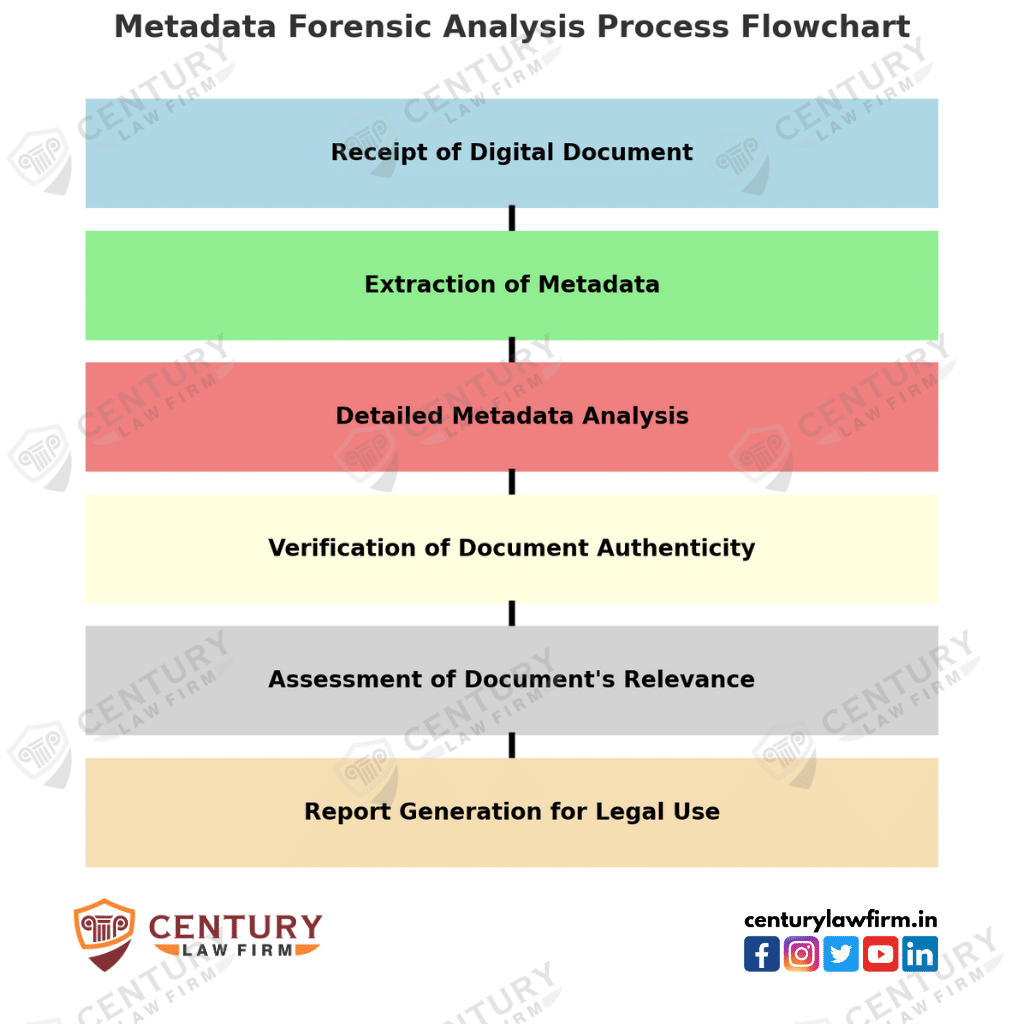
Establishing an Audit Trail & Chain of Custody
This involves maintaining a comprehensive and unbroken record of the handling of electronic evidence:
- Audit Trail: Documents every action taken on the evidence, from creation to presentation in court.
- Chain of Custody: Ensures that the evidence has been continuously and securely held, stored, and transferred, preventing any possibility of tampering or alteration.
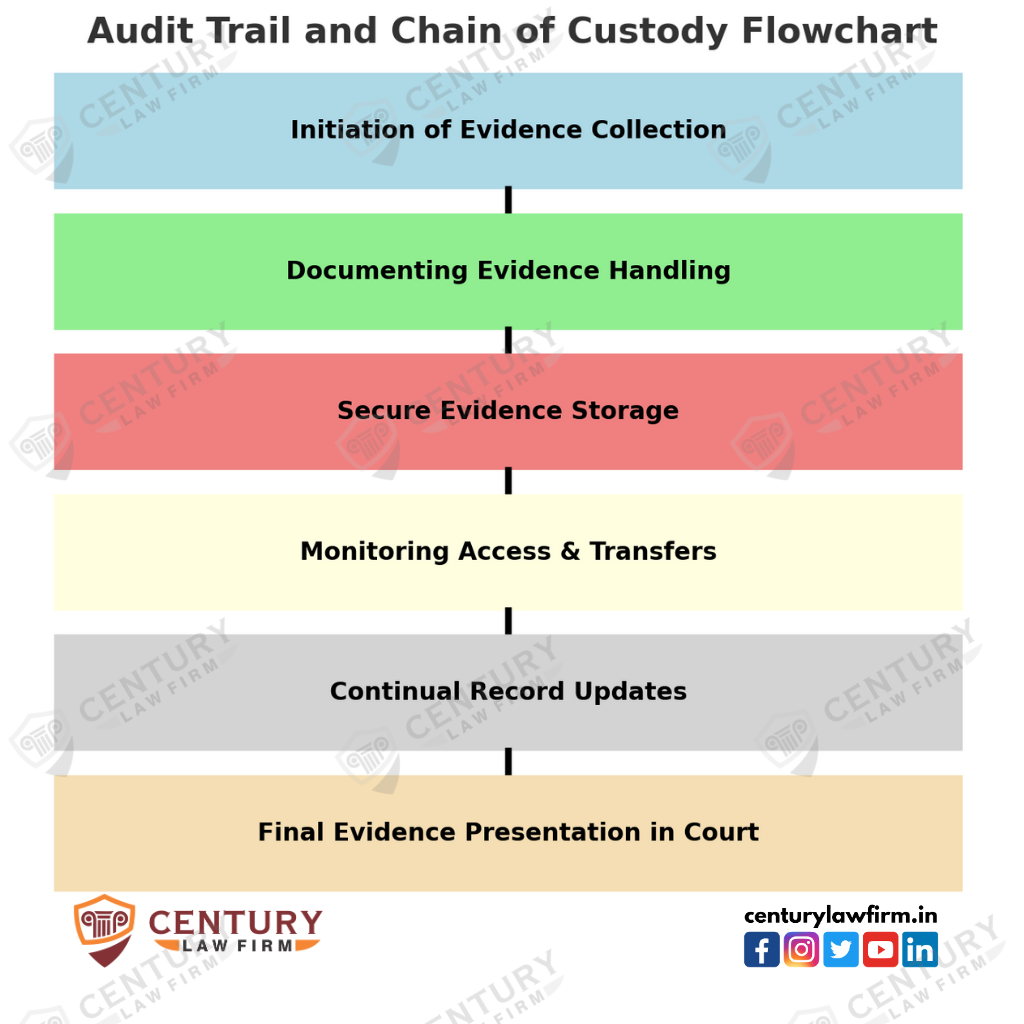
Role of Cyber Forensic Experts in Legal Proceedings
Cyber forensic experts play a critical role in legal proceedings involving electronic evidence:
- Expert Analysis: They analyze complex electronic evidence, interpret technical data, and provide insights into its authenticity and relevance.
- Testimony in Court: As expert witnesses, they explain technical aspects of the evidence to the court, aiding in its understanding and evaluation.
Guidelines for Presenting Electronic Evidence in Courts
Presenting electronic evidence in courts involves several key guidelines to ensure its admissibility and effectiveness:
- Preparation of Evidence: This includes collecting, organizing, and preparing the electronic evidence in a manner that is easy to understand and analyze. It involves converting data into formats that are court-compatible.
- Adhering to Legal Requirements: Following the legal standards for electronic evidence, such as those outlined in Section 65B of the Indian Evidence Act, is critical. This includes obtaining the necessary certifications and ensuring that the evidence is collected and presented in compliance with legal procedures.
- Clear Presentation: Electronic evidence should be presented in a clear and understandable manner. This may involve using visual aids, summaries, or expert testimonies to explain complex technical details.
- Authenticity and Integrity: The presenter must be able to establish and affirm the authenticity and integrity of the evidence, demonstrating that it has not been tampered with and is a true representation of the original digital artifact.
- Corroboration: Whenever possible, electronic evidence should be corroborated with other forms of evidence, whether digital or traditional, to strengthen its validity.
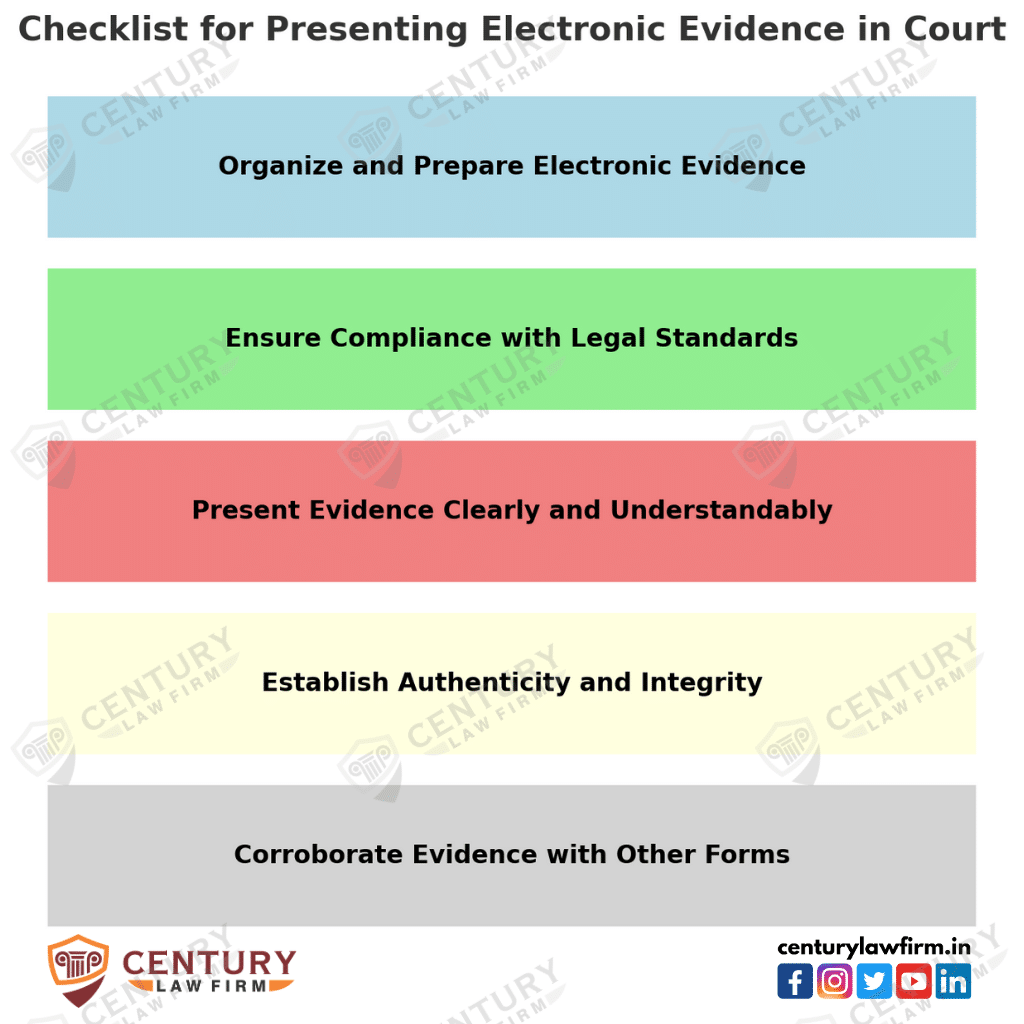
Compliance Audits and Certifications
Adhering to Standard Compliance Practices
The authenticity and integrity of electronic evidence depend substantially on the processes and systems used by organizations for data management. Best practices involve implementing rigorous compliance audits and obtaining industry certifications around information security.
Important certifications like ISO 27001 and ISO 17025 incorporate comprehensive requirements for the handling of records, access controls, storage, and data transfers. Conducting periodic audits to obtain such certifications, or confirm continued alignment, validates an organization’s electronic evidence preservation processes against stringent global benchmarks.
The audits examine factors like:
- Data access controls and user permissions
- Encryption mechanisms
- Backup and recovery provisions
- Chain of custody documentation
Undertaking compliance audits proactively establishes due diligence while positioning organizations strongly to demonstrate process maturity in the event of litigation.
Global Best Practices in Electronic Evidence Management
Globally, managing electronic evidence involves a set of best practices that ensure its integrity and admissibility:
- Standard Operating Procedures (SOPs): Establishing and following SOPs for handling electronic evidence, including collection, storage, and transfer.
- Use of Forensic Tools: Employing reliable and validated forensic tools for data extraction and analysis.
- Regular Training: Keeping law enforcement, legal professionals, and forensic experts updated with the latest technologies and methodologies.
- Data Privacy Considerations: Adhering to data privacy laws and regulations, such as the GDPR in the European Union, during the collection and handling of electronic evidence.
- Transparency and Documentation: Maintaining transparency in the handling of electronic evidence and keeping detailed documentation, including audit trails and chain of custody records.
Section 6: Role of Technology Companies
Legal Obligations for Data Preservation & Disclosure
Technology companies play a pivotal role in the realm of electronic evidence, given their position as custodians of vast amounts of digital data. Their legal obligations include:
- Data Preservation: Upon receiving a legal request, technology companies are often required to preserve relevant data in its current form, preventing any deletion or alteration.
- Compliance with Legal Requests: Responding to subpoenas, court orders, or other legal requests for data disclosure. This involves providing data in a manner that is admissible in court while respecting privacy and confidentiality agreements.
- Transparency Reports: Many companies release transparency reports detailing government requests for data, reflecting their compliance and the extent of their cooperation with legal authorities.
- Data Security: Ensuring that the data is securely stored and transmitted, safeguarding it against unauthorized access and breaches.
- Ethical Considerations: Balancing their legal obligations with ethical considerations, especially in cases involving user privacy and rights.
Responding to Subpoenas & Court Orders
When technology companies receive subpoenas or court orders for data, they must follow a defined protocol:
- Review and Validation: Initially, the company’s legal team reviews the subpoena or court order to validate its legitimacy and scope.
- Data Identification: Identifying and collecting the data specified in the request while ensuring that the scope of the data collection is within the boundaries of the legal request.
- Legal Compliance Check: Ensuring compliance with applicable laws and regulations, including user privacy rights.
- Secure Data Transfer: Transferring the required data securely to the requesting legal authority.
- Record Keeping: Maintaining records of the response process for audit and compliance purposes.
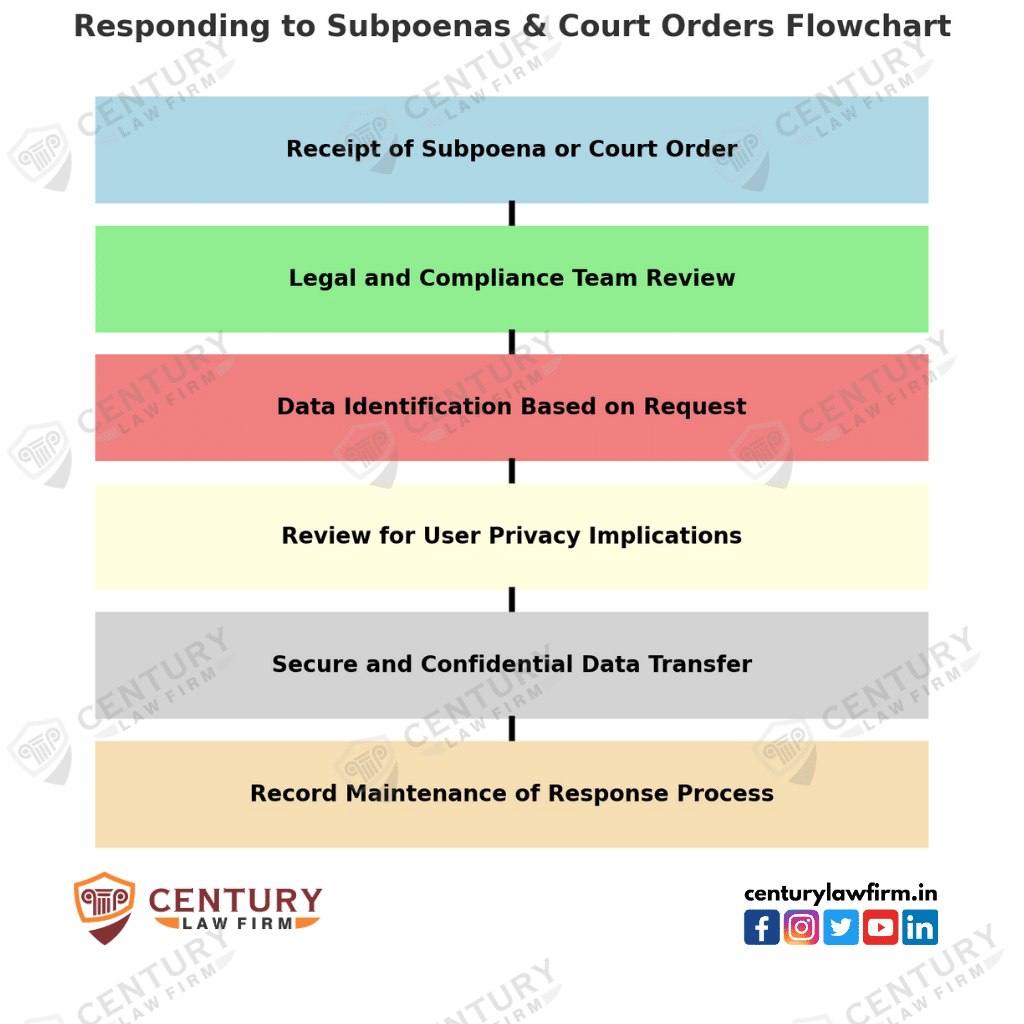
Transparency Reports & Government Requests
Transparency reports are documents published by technology companies detailing government requests for user data. These reports typically include:
- Number of Requests: The total number of government requests received within a reporting period.
- Type of Data Requested: Categories of data requested, such as user account information or content data.
- Response Rate: The rate at which the company has complied with these requests.
- Legal Justifications: The legal basis for the requests, providing insights into government surveillance and data access practices.
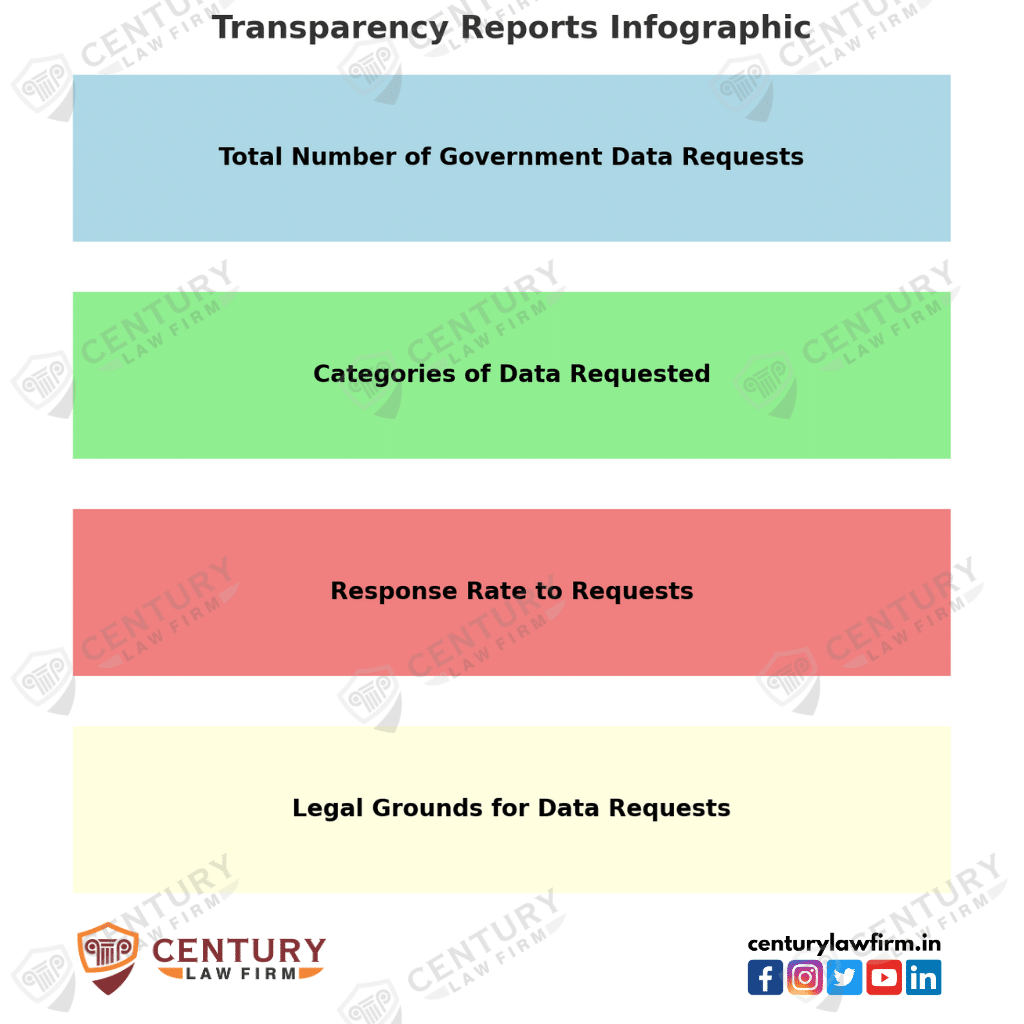
Data Protection vs Legal Obligations
Balancing data protection with legal obligations is a critical challenge for technology companies:
- User Privacy: Upholding user privacy and data protection principles, often mandated by laws like GDPR.
- Legal Compliance: Responding to legal requests for data disclosure while ensuring that such compliance does not infringe on user privacy rights.
- Ethical Considerations: Considering ethical implications and the potential impact on user trust.
Navigating GDPR & Privacy Laws
GDPR and other privacy laws impose strict regulations on data handling:
- Consent and Transparency: Requiring clear user consent for data processing and ensuring transparency in how user data is used.
- Data Minimization: Collecting only the data that is necessary for the specified purpose.
- Right to Access and Erasure: Allowing users to access their data and request its deletion.
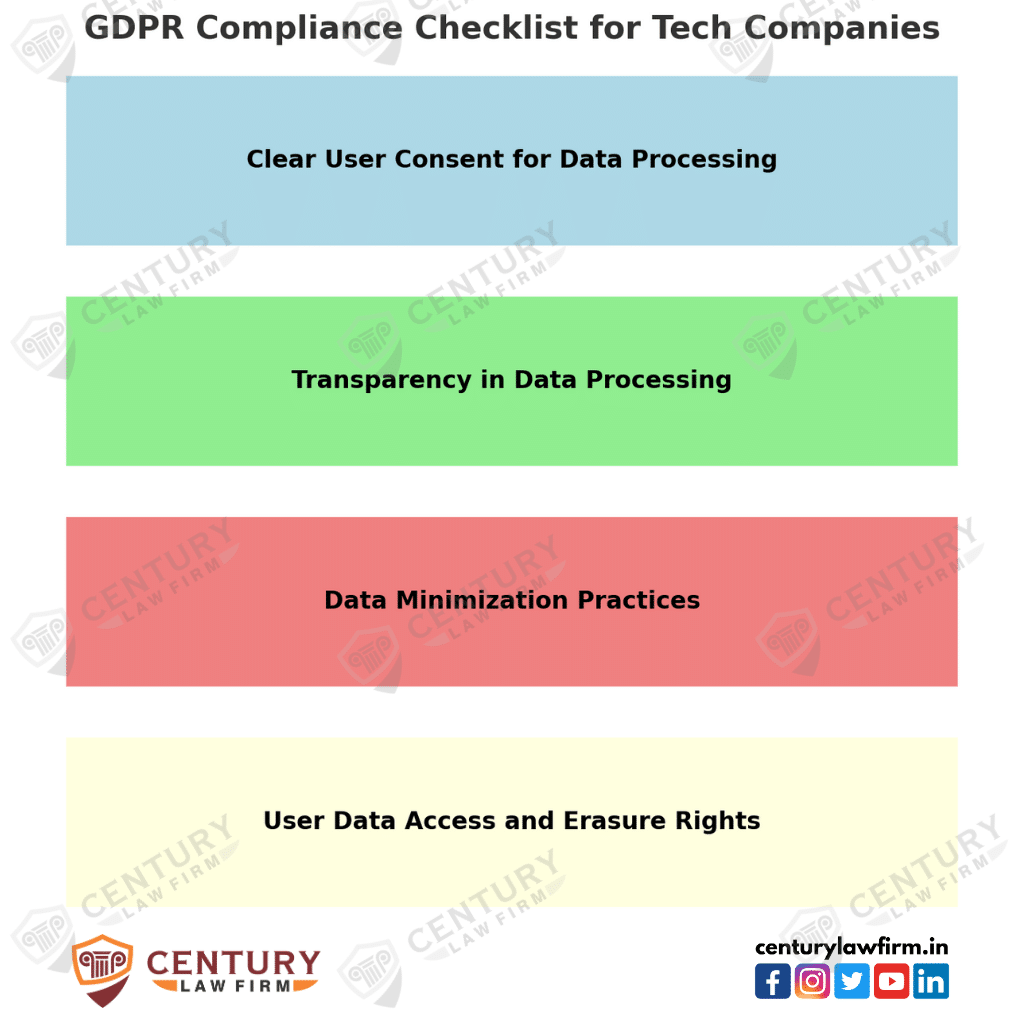
Case Studies on Tech Cos as Witnesses & Sources of Evidence
Technology companies often become crucial witnesses or sources of evidence in legal cases:
- Providing Crucial Data: Offering data that can be pivotal in legal investigations or trials.
- Expert Testimony: Company representatives may provide expert testimony on technical aspects of the data or the company’s data handling practices.
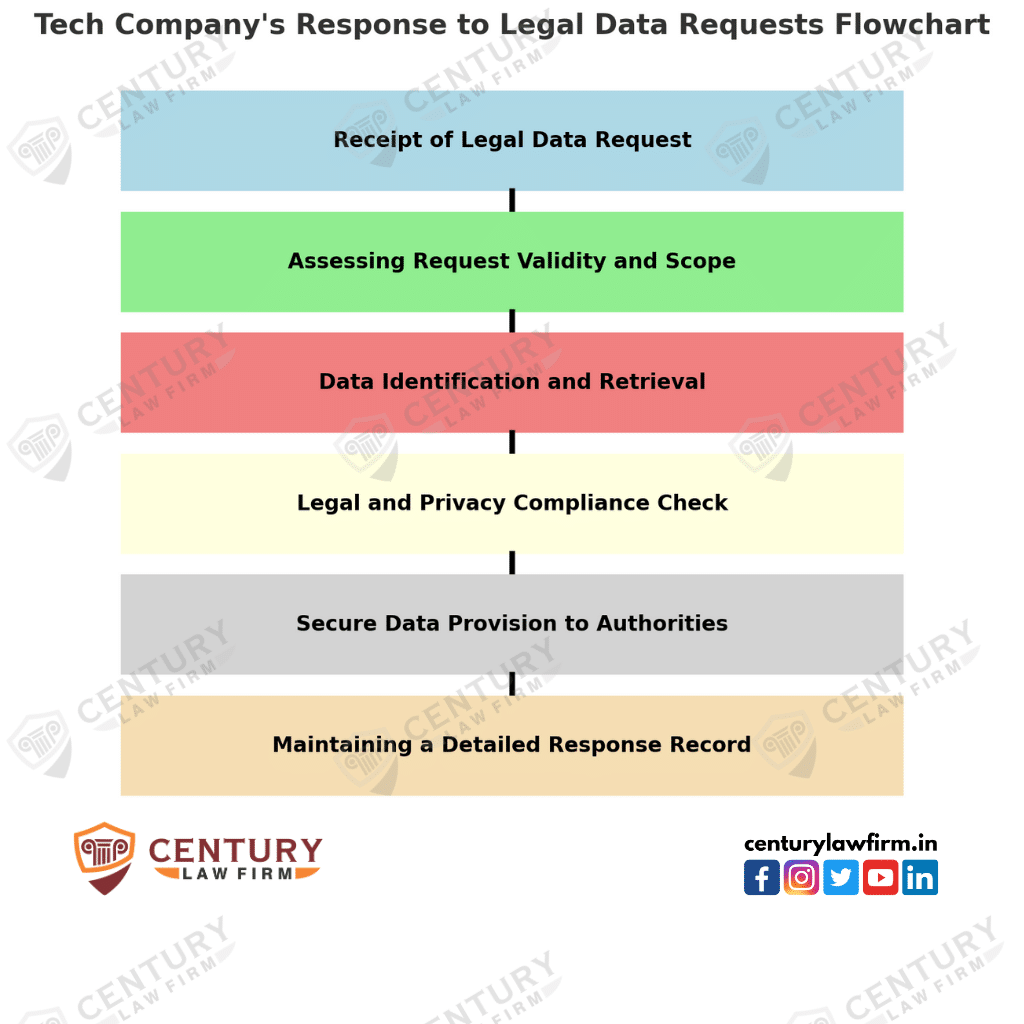
Case Studies across Industries
Applications of Electronic Evidence across Sectors
While the discourse often centers around legal cases and big tech companies, electronic evidence finds crucial applications across verticals:
Healthcare: From securing patient records to detailed electronic logs of medical devices like ventilators and dialysis machines. The comprehensive evidence trail enhances diagnostic abilities while strengthening legal compliance.
Financial Services: Recording calls in investment banking, preserving transactional data, and mining communications to profile behavioral risks leveraging AI. This augments fraud detection and systemic resilience.
E-commerce: Harnessing customer interaction transcripts, purchase records, and product reviews to resolve conflicts and build trust through transparency. Creating chain of custody for returned goods also limits processing risks.
The expansive ambit of electronic evidence calls for framing appropriate sector-specific data preservation norms and protocols.
Section 7: Emerging Trends & Future Outlook
Blockchain, AI & Data Analytics for Legal Evidence
The integration of technologies like blockchain, artificial intelligence (AI), and data analytics is reshaping the landscape of legal evidence:
Blockchain in Legal Evidence
- Tamper-Proof Records: Blockchain’s inherent nature of being immutable makes it an ideal platform for creating tamper-proof records of transactions and documents.
- Smart Contracts: Automate and record contractual processes in a transparent and unalterable way, potentially serving as self-executing legal evidence.
AI and Data Analytics
- Fraud Detection: AI algorithms can analyze patterns in large datasets to detect anomalies or fraudulent activities.
- Predictive Analytics: AI can help in predicting outcomes based on historical data, aiding legal strategies.
- Natural Language Processing (NLP): AI-driven NLP can be used to analyze vast amounts of text data, such as legal documents and communication records.
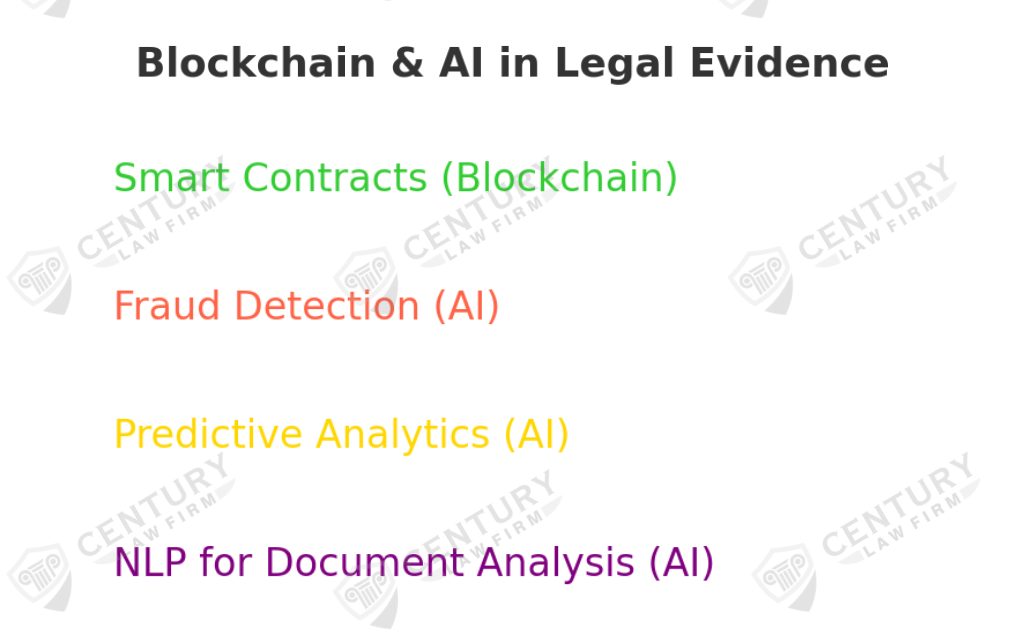
Preventing Tampering and Fraud Detection
Advanced technologies are crucial in detecting and preventing tampering:
- Digital Watermarking: Embedding information in digital media to trace and secure data.
- Cryptographic Techniques: Ensuring the integrity and confidentiality of digital evidence.
- Automated Fraud Detection Systems: Using machine learning to detect patterns indicative of fraudulent activities.
Types of Electronic Evidence Analytics
Leveraging AI for Electronic Evidence Analysis
Artificial intelligence and data analytics can analyze different forms of electronic evidence to extract actionable insights:
- Sentiment analysis algorithms can identify emotion, tone, and perceptible attitudes in audio recordings and text-based conversation transcripts.
- Computer vision techniques like object classification and scene characterization can augment the examination of photo, video and multimedia evidence.
- Text analytics and natural language processing can help discover themes and patterns across extensive documentation.
- Predictive analytics based on machine learning can determine likely outcomes given the patterns in evidence provided in historical cases.
The computational power of AI allows both targeted queries and a bird’s eye perspective across massive volumes of data, a vital capability for evidence-based decision making.
Policy Level Changes Expected
Anticipated policy changes include:
- Stricter Data Protection Laws: Enhanced regulations around data privacy and protection, influenced by frameworks like GDPR.
- Standardization of Digital Evidence Handling: Establishing uniform standards and protocols for the collection, storage, and analysis of digital evidence.
- Cross-Border Data Sharing Norms: Addressing the challenges of data sharing across jurisdictions, particularly in a globalized digital environment.
For Data Protection
Future outlook in data protection:
- User Consent and Control: Increasing emphasis on user consent and control over their personal data.
- Data Localization: Policies mandating data storage within national borders for better regulatory control.
- Enhanced Security Protocols: Adopting more robust security measures to protect data from breaches and unauthorized access.
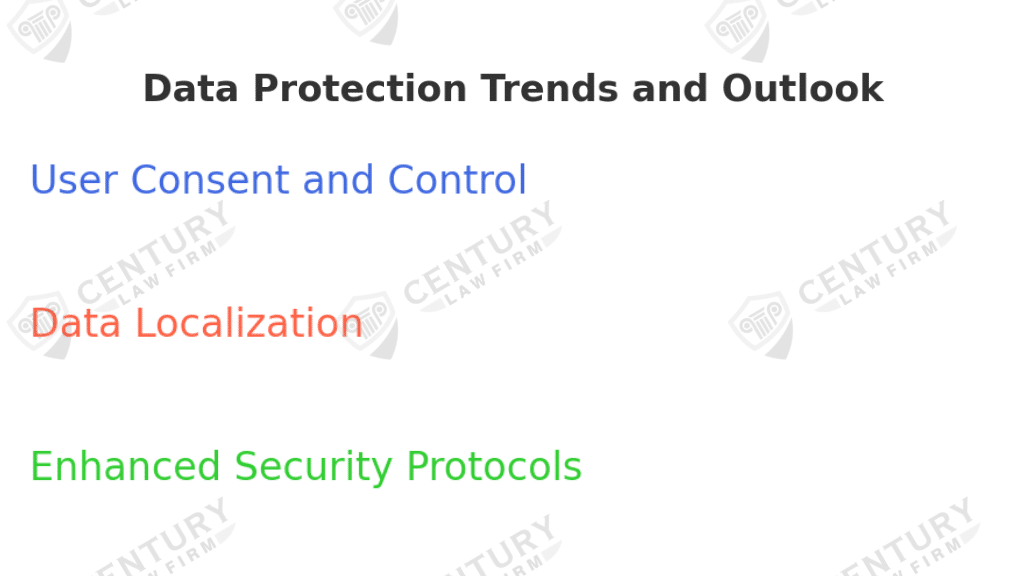
Maintaining Integrity of Judicial Processes
The integrity of judicial processes in the context of electronic evidence involves several key components:
- Verifiable Sources: Ensuring that the sources of electronic evidence are credible and can be independently verified.
- Transparent Procedures: Maintaining transparency in the collection, analysis, and presentation of digital evidence.
- Judicial Training: Educating judges and legal practitioners on the technical aspects of electronic evidence to make informed decisions.
- Checks Against Abuse: Implementing checks and balances to prevent the misuse of electronic evidence, such as falsification or misinterpretation.
Outlining an Ideal Global Framework
An ideal global framework for managing electronic evidence would include:
- Universal Standards: Developing and adopting international standards for the collection, storage, and analysis of electronic evidence.
- Interoperability: Ensuring that systems and procedures are interoperable across different jurisdictions.
- Respect for Privacy and Human Rights: Balancing the need for evidence with respect for individual privacy and human rights.
- Collaboration: Fostering collaboration among countries to facilitate the exchange of information and best practices.
Trans-border Access & Sharing Laws
In the era of globalized data, trans-border access to and sharing of electronic evidence are crucial:
- Mutual Legal Assistance Treaties (MLATs): Utilizing MLATs for cross-border legal cooperation.
- Extraterritorial Jurisdiction Considerations: Navigating the complexities of applying domestic laws to data stored in foreign jurisdictions.
- Data Sovereignty Issues: Resolving conflicts between national data protection laws and international evidence-sharing requirements.
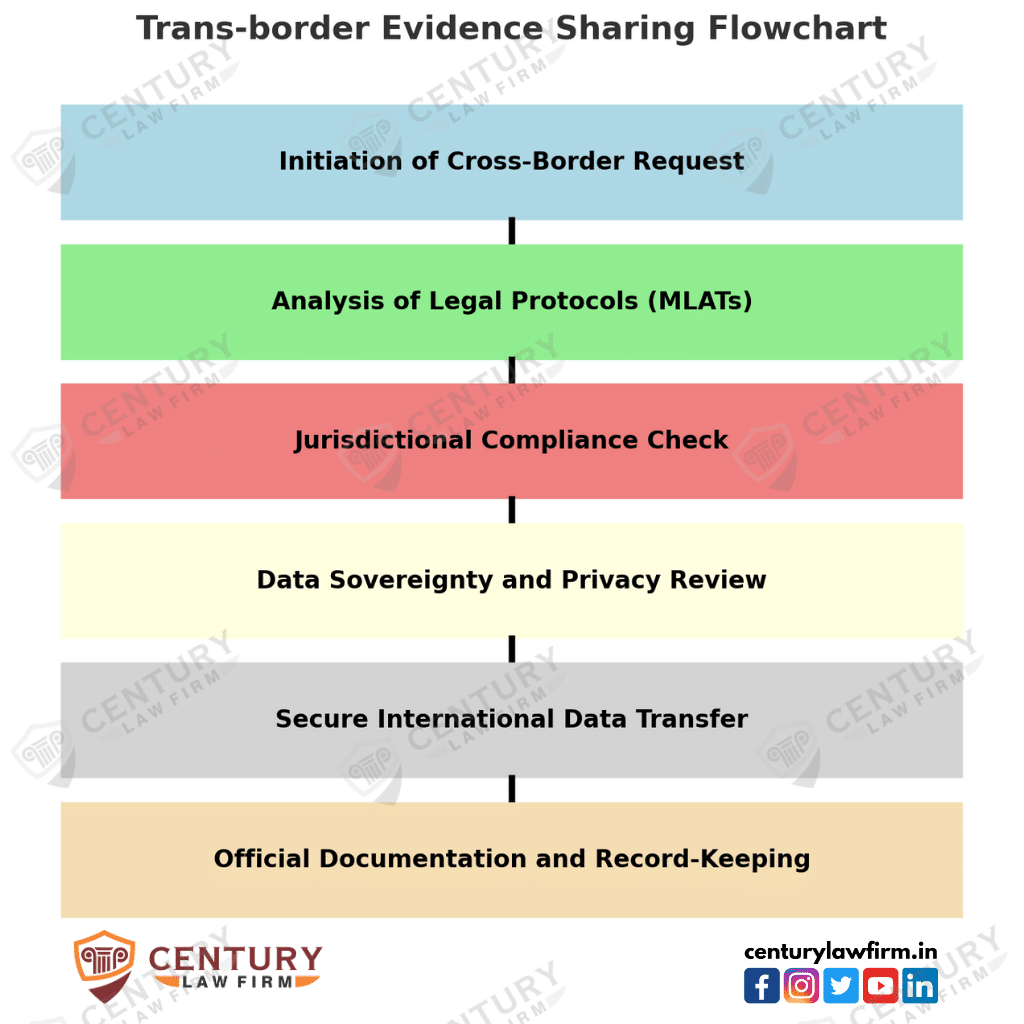
Common Criteria for Authenticity, Hearsay, etc.
Establishing common criteria internationally would aid in the uniform handling of electronic evidence:
- Authenticity Standards: Defining clear standards for what constitutes authentic digital evidence.
- Hearsay Rules Adaptation: Adapting hearsay rules to accommodate digital communications, which often involve indirect evidence.
- Chain of Custody: Establishing universal guidelines for maintaining a chain of custody for digital evidence.
Section 8: Frequently Asked Questions
Here is an extensive list of FAQs, covering a wide range of complexities related to electronic evidence and its legal implications:
Basic Questions
- What is electronic evidence? Electronic evidence refers to any information or data stored or transmitted in digital form, which is used as evidence in legal proceedings.
- Can emails be used as evidence in court? Yes, emails can be used as evidence in court, provided they meet certain criteria like authenticity, relevance, and compliance with legal standards for electronic evidence.
- How is electronic evidence different from traditional evidence? Electronic evidence differs from traditional evidence in its format (digital vs. physical) and the methods required for its authentication, storage, and presentation in legal settings.
- How do privacy laws impact access to electronic evidence? Privacy laws can restrict access to certain types of electronic evidence, especially personal data, requiring legal processes like subpoenas to access them.
- What is the role of digital forensics in electronic evidence? Digital forensics involves the recovery and investigation of material found in digital devices, crucial for uncovering, analyzing, and presenting electronic evidence.
- Can encrypted data be used as evidence? Encrypted data can be used as evidence if it can be decrypted and its relevance and authenticity can be established.
Technical Questions
- What is metadata in electronic evidence? Metadata is data about data, providing information like the author, creation date, and modification history of a digital document.
- How do courts verify the authenticity of electronic evidence? Courts verify the authenticity of electronic evidence through methods like digital signatures, metadata analysis, and expert testimony.
- What role does blockchain technology play in electronic evidence? Blockchain can enhance the integrity of electronic evidence by creating tamper-proof records and facilitating secure transactions.
Legal Questions
- What is Section 65B of the Indian Evidence Act? Section 65B of the Indian Evidence Act pertains to the admissibility of electronic records, specifying the conditions under which they are considered valid evidence.
- How does GDPR impact the handling of electronic evidence? GDPR impacts the handling of electronic evidence by enforcing strict data protection rules, especially regarding the collection and processing of personal data in electronic form.
- Can social media posts be considered as electronic evidence? Yes, social media posts can be considered as electronic evidence if they meet legal admissibility criteria like authenticity and relevance.
Advanced Questions
- What challenges do cross-border data laws pose for electronic evidence? Cross-border data laws can create challenges in accessing and sharing electronic evidence due to differing legal jurisdictions, privacy laws, and data sovereignty issues.
- How do artificial intelligence and machine learning affect electronic evidence? AI and machine learning can analyze large datasets for patterns, predict outcomes, and detect anomalies, thereby impacting the collection and interpretation of electronic evidence.
- What are the ethical considerations in the use of electronic evidence? Ethical considerations include respecting privacy rights, preventing misuse of data, and ensuring fairness in the use and interpretation of electronic evidence.
- What legal challenges arise from cloud-stored electronic evidence? Challenges include jurisdictional issues, data privacy concerns, and ensuring the integrity of evidence stored in the cloud.
- How is electronic evidence handled in international disputes? In international disputes, electronic evidence must comply with the legal standards and privacy laws of the jurisdictions involved, often requiring cooperation between nations.
- What future technologies might impact electronic evidence? Emerging technologies like quantum computing and more advanced AI algorithms could impact the collection, analysis, and integrity of electronic evidence.
- How do varying digital standards across countries affect evidence sharing? Differing digital standards can complicate the sharing of electronic evidence, necessitating harmonization efforts or bilateral agreements.
- What are the implications of deepfakes for electronic evidence? Deepfakes pose significant challenges for authenticity verification, requiring advanced tools and expertise to detect manipulations.
- How does electronic evidence interplay with human rights concerns? The use of electronic evidence must balance the need for justice with respect for human rights, including privacy and freedom of expression.
Hypothetical Questions
- If a digital document is edited, can it still be used as evidence? An edited digital document can be used as evidence if the changes are documented and explained, though its evidentiary value might be impacted.
- What happens if electronic evidence is obtained illegally? Illegally obtained electronic evidence may be deemed inadmissible in court, depending on the jurisdiction and the circumstances of the case.
- Can deleted digital data be recovered and used as evidence? Yes, deleted digital data can often be recovered using forensic techniques and, if authenticated, can be used as evidence.
Conclusion
Key Highlights & Takeaways
- Evolution of Electronic Evidence: The blog has highlighted how electronic evidence has evolved, from the initial challenges of recognition to its current pivotal role in legal proceedings.
- Legal Framework: Key legal provisions, such as Section 65B of the Indian Evidence Act and the IT Act, 2000, have been explored to understand their impact on the admissibility and handling of electronic evidence.
- Landmark Judgments: Important court decisions have been discussed, demonstrating how judicial interpretations have shaped the legal landscape of electronic evidence in India.
- Role of Technology: The integration of blockchain, AI, and data analytics in managing and authenticating electronic evidence has been a significant highlight.
- Global Context: Comparisons with global standards and practices have provided an international perspective on the handling of electronic evidence.
Summary of Current Legal Situation & Future Direction
- Current Legal Situation: Indian law has progressively adapted to accommodate the nuances of electronic evidence, with courts and legislatures recognizing its importance and challenges.
- Future Direction: Emerging technologies and global trends suggest a future where electronic evidence will be more intricately woven into the fabric of legal systems. Key areas of future development include enhanced data protection laws, standardization of digital evidence handling, and better mechanisms for cross-border data sharing.
- Continued Evolution: The legal framework for electronic evidence in India is expected to continue evolving, influenced by technological advancements, international cooperation, and changing societal norms.
As the digital landscape continues to evolve, so too will the legal frameworks and judicial approaches to electronic evidence, making it an area of ongoing interest and significance.
Topics Covered: Evolution of electronic evidence, relevant legal framework, Indian Evidence Act, IT Act, Section 65B, admissibility of electronic evidence, types of electronic evidence, authenticating electronic evidence, presenting electronic evidence in courts, role of technology companies, emerging trends, data protection and privacy, landmark judgments, cross-border data sharing, compliance audits and certifications, transparency reports, hearsay rules, chain of custody requirements, cyber forensics, metadata analysis, primary vs secondary evidence, obtaining call data records
Also Read:
The Role and Admissibility of Forensic Evidence in the Indian Criminal Justice System
Polygamy and Polygamous Marriages in India: An In-depth Look into Practices and Legal Framework
Bharatiya Nyaya Sanhita, Bharatiya Nagarik Suraksha Sanhita, and Bharatiya Sakshya Bills: An Analysis of the Reform of Indian Justice System

